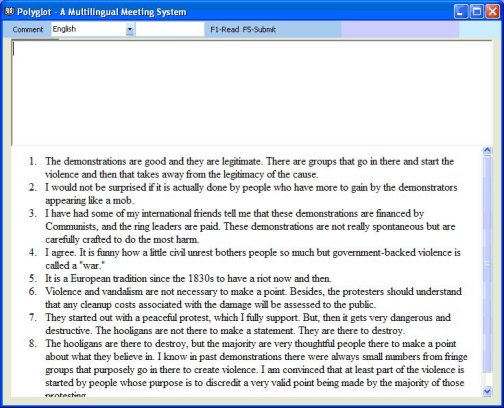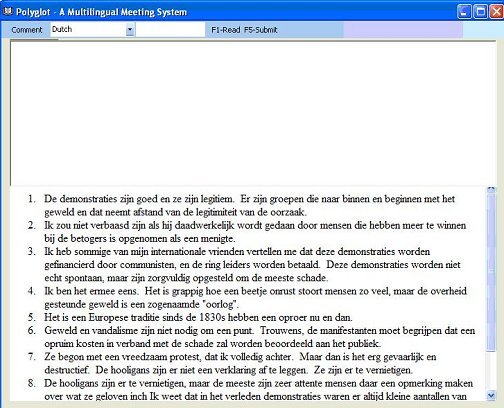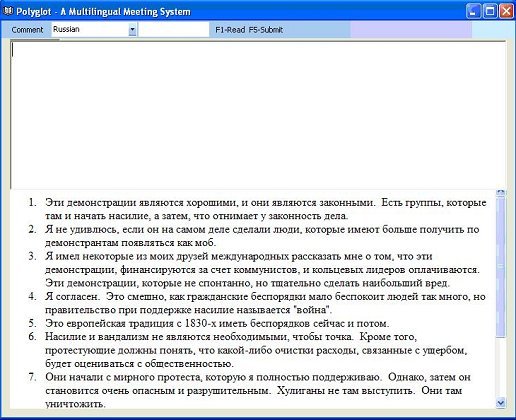Automatic Translation in Multilingual Electronic Meetings
Electronic meetings, e.g., chat rooms and bulletin boards, can be more efficient and effective than traditional, oral discussions, but until only recently, online groups speaking many languages could not benefit from machine translation (MT). Although it is possible for linguists to provide translations for the group members as they read comments during a multilingual discussion, this is not feasible for large groups and many languages. As a solution, we propose a fully automated multilingual meeting system, and an example of its use in a meeting with comments typed in English translated to Dutch and Russian illustrates its potential to reduce many multinational communication barriers.
Introduction.
In the past, oral meetings involving speakers of multiple languages required participants to adopt a common language, e.g. English, or use interpreters. In the former case, all participants might not be fluent in the non-native language and could be uncomfortable speaking it. In the latter case, human interpreters could be expensive and difficult to schedule.
<TABLE cellSpacing=5 cellPadding=5 width=200 align=left><TBODY><TR><TD>Early results indicate a high level of comprehension for many translated comments, and future research will investigate the accuracy of more complex sentence translations.
</TD></TR></TBODY></TABLE>Many studies have shown that people speaking a single language can use computer-based group support systems to improve the efficiency and effectiveness of meetings focused on sharing ideas among many participants. In these electronic meetings, group members can type and read comments simultaneously while all text is automatically recorded to a file. Because these meetings often provide anonymous input of ideas, experiments have shown that people participate more, generate more solutions to problems, take less time, and are more satisfied with the meeting process (Adkins, et al., 2003; Fjermestad & Hiltz, 2001).
Electronic meetings can support multiple languages with the integration of machine translation (Fügen, et al., 2007; Lim &Yang, 2008). Using such a system, group members could contribute typed comments in their own native languages while others' comments typed in different languages are translated automatically for presentation on the appropriate screens.
In this paper, we describe six Web-based machine translation services that can be used to assist with the understanding of foreign text and seven electronic chat systems that provide translations between language pairs. Then, we introduce a new, locally developed multilingual electronic meeting system that provides automatic translation among 41 languages. Finally, in a test of comprehension accuracy, we rank the languages using five simple phrases.
Web-based machine translation
Since the late-1990s with the introduction of Babelfish on the Web(Yang & Lange, 1998), free, online translators have been available for use on text, documents, and Web pages. Currently, there are at least six free services (shown in Table 1) that provide support for different numbers of language pairs (e.g., English to Spanish, French to Russian, Chinese to English, etc.).
Table 1: Free Web-based translation services
Automated multilingual meetings
Despite the first multilingual application appearing in the early 1990s that automatically translated between English and Spanish in an electronic meeting (Aiken, et al.,1992; Aiken, et al., 1994), at least two United States patents were filed several years later which claimed to do essentially the same thing:
<DIR>1. US Patent 5966685 - System for parallel foreign language communication over a computer network (Flanagan, et al, 1999)
US Patent Issued on October 12, 1999
Abstract: A system is disclosed which allows for an electronic discussion group user to communicate with another user who speaks a different language. Machine translators and other software are incorporated to translate messages, thereby creating parallel discussion groups in different languages.
2. US Patent 5987401 - Language translation for real-time text-based conversations
US Patent Issued on November 16, 1999 (Trudeau, 1999)
Abstract: A real-time language translation technique for text-based conversations. The messages forming the text-based conversation amongst a plurality of participants to the conversation are translated in real-time either from a user language to a conversation language of the conversation, or from the conversation language to the user language. The result is that the user is able to seamlessly converse in a text-based conversation (in the conversation language) using a language other than the conversation language. The invention is particularly advantageous for on-line text-based conversations, wherein users of on-line text-based conversations are able to seamlessly converse with each other in different languages.
</DIR>Subsequently, at least seven applications (shown in Table 2) were developed that provide automatic translation for instant messaging between pairs of individuals.
Table 2: Online chat systems with automatic translation
Polyglot
To provide support for large, multilingual groups in an electronic meeting, we developed a prototype system that allows participants to type comments anonymously and simultaneously while being able to read all others' comments at the same time. The software has been designated Polyglot ("many tongues"), and it uses the Google Translate application programming interface (API) to perform translations between any of 41 languages (1,640 language pairs). Unlike many other MT systems, Google Translate is based upon a statistical translation system in which a language model is trained on billions of words of equivalent text in many different languages, e.g., comparing the Bible written in German versus the book written in Russian, and comprehension results have been very good (Geer, 2005). Relatively few evaluations of free, online MT systems have been conducted (e.g., Aiken, et al., 2006; Bezhanova, et al., 2005), but one study (NIST, 2005) of 20 free, commercial, and research MT systems showed that Google Translate was the most accurate in three of four tests.
At least seven mashups, i.e., software that combine two or more tools to create new services (Ennals & Garofalakis, 2007), have already been developed with the Google Translate API including MultiTranslator that provides translation in many languages at the same time (Programmableweb, 2009), and researchers are developing new applications every day (Grubinger, et al., 2008).
Figures 1 to 3 show an example of how Polyglot can be used by a multilingual group discussing the G20 protests in London (Telegraph, 2009) in English, Dutch, and Russian. Each user types a comment in the top textbox, and within two or three seconds, it is available for the other participants to read in their native languages at their own computers in the lower textbox.
Figure 1: English participants' view of multilingual meeting

Figure 2: Dutch participants' view of multilingual meeting

Figure 3: </B>Russian participants' view of multilingual meeting

Translation comprehension is still far from perfect because Google Translate's accuracy varies with sentence and vocabulary complexity and by language. In an attempt to judge Polyglot's potential performance, two objective, English-speaking evaluators ranked the 40 non-English languages supported by Google Translate based on the scales provided by Guyon (2003):
<DIR>Comprehension
</DIR>
</DIR>
</DIR>
Table 3: Ranking of 40 non-English languages supported by Google Translate
(lower score better)
The multilingual meeting prototype described here can support large groups using up to 41 languages with translations provided automatically within a few seconds via a link with Google Translate. Early results indicate a high level of comprehension for many translated comments, and future research will investigate the accuracy of more complex sentence translations as well as how the prototype performs with other languages.
References
This article was originally published at Translation Journal (http://accurapid.com/journal).
By Milam Aiken,
a Professor and Chair of Management Information Systems in the School of Business Administration at the University of Mississippi, U.S.A.
maiken at bus olemiss edu
Mina Park,
a Ph.D. candidate in Management Information Systems at the University of Mississippi, U.S.A.
mpark at bus olemiss edu
Lakisha Simmons,
a doctoral student in Management Information Systems at The University of Mississippi, U.S.A.
lsimmons at bus olemiss edu
Tobin Lindblom,
an Assistant Professor of Management Information Systems at Northern State University in South Dakota, U.S.A.
Tobin Lindblom at northern edu
=========
Abstracta Professor and Chair of Management Information Systems in the School of Business Administration at the University of Mississippi, U.S.A.
maiken at bus olemiss edu
Mina Park,
a Ph.D. candidate in Management Information Systems at the University of Mississippi, U.S.A.
mpark at bus olemiss edu
Lakisha Simmons,
a doctoral student in Management Information Systems at The University of Mississippi, U.S.A.
lsimmons at bus olemiss edu
Tobin Lindblom,
an Assistant Professor of Management Information Systems at Northern State University in South Dakota, U.S.A.
Tobin Lindblom at northern edu
=========
<TABLE style="FONT-SIZE: 8pt; COLOR: black; FONT-FAMILY: Verdana" cellSpacing=0 cellPadding=4 width="100%" border=0><TBODY><TR><TD vAlign=top align=middle width="25%"> </TD><TD vAlign=top align=middle width="25%">
</TD><TD vAlign=top align=middle width="25%"> </TD><TD vAlign=top align=middle width="25%">
</TD><TD vAlign=top align=middle width="25%"> </TD><TD vAlign=top align=middle width="25%">
</TD><TD vAlign=top align=middle width="25%"> </TD></TR><TR><TD align=middle roundtrip="0" lastVisited="0">Milam Aiken</TD><TD align=middle roundtrip="0" lastVisited="0">Mina Park</TD><TD align=middle roundtrip="0" lastVisited="0">Lakisha Simmons</TD><TD align=middle roundtrip="0" lastVisited="0">Tobin Lindblom</TD></TR></TBODY></TABLE>
</TD></TR><TR><TD align=middle roundtrip="0" lastVisited="0">Milam Aiken</TD><TD align=middle roundtrip="0" lastVisited="0">Mina Park</TD><TD align=middle roundtrip="0" lastVisited="0">Lakisha Simmons</TD><TD align=middle roundtrip="0" lastVisited="0">Tobin Lindblom</TD></TR></TBODY></TABLE>
 </TD><TD vAlign=top align=middle width="25%">
</TD><TD vAlign=top align=middle width="25%"> </TD><TD vAlign=top align=middle width="25%">
</TD><TD vAlign=top align=middle width="25%"> </TD><TD vAlign=top align=middle width="25%">
</TD><TD vAlign=top align=middle width="25%"> </TD></TR><TR><TD align=middle roundtrip="0" lastVisited="0">Milam Aiken</TD><TD align=middle roundtrip="0" lastVisited="0">Mina Park</TD><TD align=middle roundtrip="0" lastVisited="0">Lakisha Simmons</TD><TD align=middle roundtrip="0" lastVisited="0">Tobin Lindblom</TD></TR></TBODY></TABLE>
</TD></TR><TR><TD align=middle roundtrip="0" lastVisited="0">Milam Aiken</TD><TD align=middle roundtrip="0" lastVisited="0">Mina Park</TD><TD align=middle roundtrip="0" lastVisited="0">Lakisha Simmons</TD><TD align=middle roundtrip="0" lastVisited="0">Tobin Lindblom</TD></TR></TBODY></TABLE>Electronic meetings, e.g., chat rooms and bulletin boards, can be more efficient and effective than traditional, oral discussions, but until only recently, online groups speaking many languages could not benefit from machine translation (MT). Although it is possible for linguists to provide translations for the group members as they read comments during a multilingual discussion, this is not feasible for large groups and many languages. As a solution, we propose a fully automated multilingual meeting system, and an example of its use in a meeting with comments typed in English translated to Dutch and Russian illustrates its potential to reduce many multinational communication barriers.
Introduction.
In the past, oral meetings involving speakers of multiple languages required participants to adopt a common language, e.g. English, or use interpreters. In the former case, all participants might not be fluent in the non-native language and could be uncomfortable speaking it. In the latter case, human interpreters could be expensive and difficult to schedule.
<TABLE cellSpacing=5 cellPadding=5 width=200 align=left><TBODY><TR><TD>Early results indicate a high level of comprehension for many translated comments, and future research will investigate the accuracy of more complex sentence translations.
</TD></TR></TBODY></TABLE>Many studies have shown that people speaking a single language can use computer-based group support systems to improve the efficiency and effectiveness of meetings focused on sharing ideas among many participants. In these electronic meetings, group members can type and read comments simultaneously while all text is automatically recorded to a file. Because these meetings often provide anonymous input of ideas, experiments have shown that people participate more, generate more solutions to problems, take less time, and are more satisfied with the meeting process (Adkins, et al., 2003; Fjermestad & Hiltz, 2001).
Electronic meetings can support multiple languages with the integration of machine translation (Fügen, et al., 2007; Lim &Yang, 2008). Using such a system, group members could contribute typed comments in their own native languages while others' comments typed in different languages are translated automatically for presentation on the appropriate screens.
In this paper, we describe six Web-based machine translation services that can be used to assist with the understanding of foreign text and seven electronic chat systems that provide translations between language pairs. Then, we introduce a new, locally developed multilingual electronic meeting system that provides automatic translation among 41 languages. Finally, in a test of comprehension accuracy, we rank the languages using five simple phrases.
Web-based machine translation
Since the late-1990s with the introduction of Babelfish on the Web(Yang & Lange, 1998), free, online translators have been available for use on text, documents, and Web pages. Currently, there are at least six free services (shown in Table 1) that provide support for different numbers of language pairs (e.g., English to Spanish, French to Russian, Chinese to English, etc.).
Table 1: Free Web-based translation services
<TABLE style="FONT-SIZE: 10pt; COLOR: black; FONT-FAMILY: Verdana" cellSpacing=0 cellPadding=4 width=520 border=1><TBODY><TR><TD vAlign=top width="23%">Service
</TD><TD vAlign=top width="46%">URL
</TD><TD vAlign=top width="16%">Underlying MT
</TD><TD vAlign=top width="16%">Language Pairs
</TD></TR><TR><TD vAlign=top width="23%">Babelfish
</TD><TD vAlign=top width="46%">http://babelfish.yahoo.com
</TD><TD vAlign=top width="16%">Systran
</TD><TD vAlign=top width="16%">
</TD><TD vAlign=top width="46%">www.freetranslation.com
</TD><TD vAlign=top width="16%">SDL
</TD><TD vAlign=top width="16%">
</TD><TD vAlign=top width="46%">http://translate.google.com
</TD><TD vAlign=top width="16%">Google
</TD><TD vAlign=top width="16%">
</TD><TD vAlign=top width="46%">www.online-translator.com
</TD><TD vAlign=top width="16%">PROMT
</TD><TD vAlign=top width="16%">
</TD><TD vAlign=top width="46%">www.reverso.net
</TD><TD vAlign=top width="16%">Reverso
</TD><TD vAlign=top width="16%">
</TD><TD vAlign=top width="46%">http://www2.worldlingo.com
</TD><TD vAlign=top width="16%">Worldlingo
</TD><TD vAlign=top width="16%">
Using these Web sites, chat room participants could translate foreign comments, but conducting these translations can be confusing to group members (Flanagan, 1997). Group members are not likely to put forth the effort when faced with many comments in different languages, and a meeting facilitator providing translations for the discussion using these systems will be overwhelmed with the task once the group size reaches 5 or 6 with more than 2 or 3 languages (O'Hagan & Ashworth, 2002). More staff members could be added to help with the translations, but coordination would be difficult as they lost track of which comments were translated and which were not. Instead, automated translation is needed in multilingual electronic meetings.</TD><TD vAlign=top width="46%">URL
</TD><TD vAlign=top width="16%">Underlying MT
</TD><TD vAlign=top width="16%">Language Pairs
</TD></TR><TR><TD vAlign=top width="23%">Babelfish
</TD><TD vAlign=top width="46%">http://babelfish.yahoo.com
</TD><TD vAlign=top width="16%">Systran
</TD><TD vAlign=top width="16%">
38
</TD></TR><TR><TD vAlign=top width="23%">Freetranslation</TD><TD vAlign=top width="46%">www.freetranslation.com
</TD><TD vAlign=top width="16%">SDL
</TD><TD vAlign=top width="16%">
19
</TD></TR><TR><TD vAlign=top width="23%">Google Translate</TD><TD vAlign=top width="46%">http://translate.google.com
</TD><TD vAlign=top width="16%">Google
</TD><TD vAlign=top width="16%">
1,640
</TD></TR><TR><TD vAlign=top width="23%">Online-translator</TD><TD vAlign=top width="46%">www.online-translator.com
</TD><TD vAlign=top width="16%">PROMT
</TD><TD vAlign=top width="16%">
24
</TD></TR><TR><TD vAlign=top width="23%">Reverso</TD><TD vAlign=top width="46%">www.reverso.net
</TD><TD vAlign=top width="16%">Reverso
</TD><TD vAlign=top width="16%">
19
</TD></TR><TR><TD vAlign=top width="23%">Worldlingo</TD><TD vAlign=top width="46%">http://www2.worldlingo.com
</TD><TD vAlign=top width="16%">Worldlingo
</TD><TD vAlign=top width="16%">
225
</TD></TR></TBODY></TABLE>Automated multilingual meetings
Despite the first multilingual application appearing in the early 1990s that automatically translated between English and Spanish in an electronic meeting (Aiken, et al.,1992; Aiken, et al., 1994), at least two United States patents were filed several years later which claimed to do essentially the same thing:
<DIR>1. US Patent 5966685 - System for parallel foreign language communication over a computer network (Flanagan, et al, 1999)
US Patent Issued on October 12, 1999
Abstract: A system is disclosed which allows for an electronic discussion group user to communicate with another user who speaks a different language. Machine translators and other software are incorporated to translate messages, thereby creating parallel discussion groups in different languages.
2. US Patent 5987401 - Language translation for real-time text-based conversations
US Patent Issued on November 16, 1999 (Trudeau, 1999)
Abstract: A real-time language translation technique for text-based conversations. The messages forming the text-based conversation amongst a plurality of participants to the conversation are translated in real-time either from a user language to a conversation language of the conversation, or from the conversation language to the user language. The result is that the user is able to seamlessly converse in a text-based conversation (in the conversation language) using a language other than the conversation language. The invention is particularly advantageous for on-line text-based conversations, wherein users of on-line text-based conversations are able to seamlessly converse with each other in different languages.
</DIR>Subsequently, at least seven applications (shown in Table 2) were developed that provide automatic translation for instant messaging between pairs of individuals.
Table 2: Online chat systems with automatic translation
<TABLE style="FONT-SIZE: 10pt; COLOR: black; FONT-FAMILY: Verdana" cellSpacing=0 cellPadding=4 width=520 border=1><TBODY><TR><TD vAlign=top width="19%">Application
</TD><TD vAlign=top width="66%">URL
</TD><TD vAlign=top width="14%">Languages
</TD></TR><TR><TD vAlign=top width="19%">Amikai
</TD><TD vAlign=top width="66%">http://www.riskworld.com/
</TD><TD vAlign=top width="14%">
</TD><TD vAlign=top width="66%">http://www.langrid.org/
</TD><TD vAlign=top width="14%">
</TD><TD vAlign=top width="66%">http://www.chattranslator.com/
</TD><TD vAlign=top width="14%">
</TD><TD vAlign=top width="66%">http://openaimblog.aol.com/
</TD><TD vAlign=top width="14%">
</TD><TD vAlign=top width="66%">http://www.programmableweb.com/
</TD><TD vAlign=top width="14%">
</TD><TD vAlign=top width="66%">http://my.advisor.com/doc/07484
http://www-01.ibm.com/software/lotus/sametime/
</TD><TD vAlign=top width="14%">
</TD><TD vAlign=top width="66%">http://meglobe.com/
</TD><TD vAlign=top width="14%">
</TD><TD vAlign=top width="66%">http://www.worldlingo.com/
</TD><TD vAlign=top width="14%">
However, multilingual meetings usually involve more than two people, and they often use more than two languages. We believe there is no system available that can accommodate such a group by automatically translating among several languages at once, but there is a clear need for such an application.</TD><TD vAlign=top width="66%">URL
</TD><TD vAlign=top width="14%">Languages
</TD></TR><TR><TD vAlign=top width="19%">Amikai
</TD><TD vAlign=top width="66%">http://www.riskworld.com/
</TD><TD vAlign=top width="14%">
9
</TD></TR><TR><TD vAlign=top width="19%">Annochat</TD><TD vAlign=top width="66%">http://www.langrid.org/
</TD><TD vAlign=top width="14%">
4
</TD></TR><TR><TD vAlign=top width="19%">ChatTranslator</TD><TD vAlign=top width="66%">http://www.chattranslator.com/
</TD><TD vAlign=top width="14%">
7
</TD></TR><TR><TD vAlign=top width="19%">Free2IM</TD><TD vAlign=top width="66%">http://openaimblog.aol.com/
</TD><TD vAlign=top width="14%">
13
</TD></TR><TR><TD vAlign=top width="19%">Hab.la Realtime Chat</TD><TD vAlign=top width="66%">http://www.programmableweb.com/
</TD><TD vAlign=top width="14%">
41
</TD></TR><TR><TD vAlign=top width="19%">IBM Lotus Sametime</TD><TD vAlign=top width="66%">http://my.advisor.com/doc/07484
http://www-01.ibm.com/software/lotus/sametime/
</TD><TD vAlign=top width="14%">
7
</TD></TR><TR><TD vAlign=top width="19%">MeGlobe</TD><TD vAlign=top width="66%">http://meglobe.com/
</TD><TD vAlign=top width="14%">
15
</TD></TR><TR><TD vAlign=top width="19%">WorldLingo Chat</TD><TD vAlign=top width="66%">http://www.worldlingo.com/
</TD><TD vAlign=top width="14%">
15
</TD></TR></TBODY></TABLE>Polyglot
To provide support for large, multilingual groups in an electronic meeting, we developed a prototype system that allows participants to type comments anonymously and simultaneously while being able to read all others' comments at the same time. The software has been designated Polyglot ("many tongues"), and it uses the Google Translate application programming interface (API) to perform translations between any of 41 languages (1,640 language pairs). Unlike many other MT systems, Google Translate is based upon a statistical translation system in which a language model is trained on billions of words of equivalent text in many different languages, e.g., comparing the Bible written in German versus the book written in Russian, and comprehension results have been very good (Geer, 2005). Relatively few evaluations of free, online MT systems have been conducted (e.g., Aiken, et al., 2006; Bezhanova, et al., 2005), but one study (NIST, 2005) of 20 free, commercial, and research MT systems showed that Google Translate was the most accurate in three of four tests.
At least seven mashups, i.e., software that combine two or more tools to create new services (Ennals & Garofalakis, 2007), have already been developed with the Google Translate API including MultiTranslator that provides translation in many languages at the same time (Programmableweb, 2009), and researchers are developing new applications every day (Grubinger, et al., 2008).
Figures 1 to 3 show an example of how Polyglot can be used by a multilingual group discussing the G20 protests in London (Telegraph, 2009) in English, Dutch, and Russian. Each user types a comment in the top textbox, and within two or three seconds, it is available for the other participants to read in their native languages at their own computers in the lower textbox.
Figure 1: English participants' view of multilingual meeting

Figure 2: Dutch participants' view of multilingual meeting

Figure 3: </B>Russian participants' view of multilingual meeting

Translation comprehension is still far from perfect because Google Translate's accuracy varies with sentence and vocabulary complexity and by language. In an attempt to judge Polyglot's potential performance, two objective, English-speaking evaluators ranked the 40 non-English languages supported by Google Translate based on the scales provided by Guyon (2003):
<DIR>Comprehension
</DIR>
- <LI roundtrip="0" lastVisited="0">The text is clear, easy to understand and grammatically correct and does not require any corrections. <LI roundtrip="0" lastVisited="0">The text contains minor errors such as incorrect prepositions or articles, but is otherwise impeccable. <LI roundtrip="0" lastVisited="0">The text is a mixture of minor errors and incorrect terms, but the meaning is still understandable. <LI roundtrip="0" lastVisited="0">The text is a mixture of minor errors and incorrect terms, and it takes a definite effort to understand the meaning.
- The text is incomprehensible gibberish.
</DIR>
- <LI roundtrip="0" lastVisited="0">The text is perfectly acceptable. <LI roundtrip="0" lastVisited="0">The reader notices slight anomalies in the text. <LI roundtrip="0" lastVisited="0">The reader feels somewhat uncomfortable reading the text. <LI roundtrip="0" lastVisited="0">The reader has the impression that the text is not very serious.
- The reader feels insulted to have been presented with such a text.
</DIR>
- <LI roundtrip="0" lastVisited="0">The translation conveys the meaning of the original exactly. <LI roundtrip="0" lastVisited="0">Minor nuances are missing. <LI roundtrip="0" lastVisited="0">The translation more or less conveys the meaning of the original. <LI roundtrip="0" lastVisited="0">The translation does not convey the meaning of the original very accurately.
- The translation does not convey the meaning of the original at all.
- <LI roundtrip="0" lastVisited="0">Pleased to meet you. <LI roundtrip="0" lastVisited="0">My hovercraft is full of eels. <LI roundtrip="0" lastVisited="0">One language is never enough. <LI roundtrip="0" lastVisited="0">I don't understand.
- I love you.
Table 3: Ranking of 40 non-English languages supported by Google Translate
(lower score better)
<TABLE style="FONT-SIZE: 10pt; COLOR: black; FONT-FAMILY: Verdana" cellSpacing=0 cellPadding=4 width=520 border=1><TBODY><TR><TD vAlign=center width="15%" rowSpan=2>
</TD><TD vAlign=center width="14%">
</TD><TD vAlign=center width="14%">
</TD><TD vAlign=center width="14%">
</TD><TD vAlign=center width="14%">
</TD><TD vAlign=center width="14%">
</TD><TD vAlign=center width="14%">
</TD><TD vAlign=center width="14%">
</TD><TD vAlign=center width="14%">
</TD><TD vAlign=center width="14%">
</TD><TD vAlign=center width="14%">
</TD><TD vAlign=center width="14%">
</TD><TD vAlign=center width="14%">
</TD><TD vAlign=center width="14%">
</TD><TD vAlign=center width="14%">
</TD><TD vAlign=center width="14%">
</TD><TD vAlign=center width="14%">
</TD><TD vAlign=center width="14%">
</TD><TD vAlign=center width="14%">
</TD><TD vAlign=center width="14%">
</TD><TD vAlign=center width="14%">
</TD><TD vAlign=center width="14%">
</TD><TD vAlign=center width="14%">
</TD><TD vAlign=center width="14%">
</TD><TD vAlign=center width="14%">
</TD><TD vAlign=center width="14%">
</TD><TD vAlign=center width="14%">
</TD><TD vAlign=center width="14%">
</TD><TD vAlign=center width="14%">
</TD><TD vAlign=center width="14%">
</TD><TD vAlign=center width="14%">
</TD><TD vAlign=center width="14%">
</TD><TD vAlign=center width="14%">
</TD><TD vAlign=center width="14%">
</TD><TD vAlign=center width="14%">
</TD><TD vAlign=center width="14%">
</TD><TD vAlign=center width="14%">
</TD><TD vAlign=center width="14%">
</TD><TD vAlign=center width="14%">
</TD><TD vAlign=center width="14%">
</TD><TD vAlign=center width="14%">
ConclusionLanguage
</TD><TD vAlign=center width="28%" colSpan=2>Comprehension
</TD><TD vAlign=center width="28%" colSpan=2>Acceptability
</TD><TD vAlign=center width="28%" colSpan=2>Meaning
</TD></TR><TR><TD vAlign=center width="14%">Rank
</TD><TD vAlign=center width="14%">Score
</TD><TD vAlign=center width="14%">Rank
</TD><TD vAlign=center width="14%">Score
</TD><TD vAlign=center width="14%">Rank
</TD><TD vAlign=center width="14%">Score
</TD></TR><TR><TD vAlign=top width="15%">Dutch</TD><TD vAlign=center width="14%">
1
</TD><TD vAlign=center width="14%">1.3
</TD><TD vAlign=center width="14%">1
</TD><TD vAlign=center width="14%">1.3
</TD><TD vAlign=center width="14%">3
</TD><TD vAlign=center width="14%">1.5
</TD></TR><TR><TD vAlign=top width="15%">Hungarian</TD><TD vAlign=center width="14%">
1
</TD><TD vAlign=center width="14%">1.3
</TD><TD vAlign=center width="14%">1
</TD><TD vAlign=center width="14%">1.3
</TD><TD vAlign=center width="14%">3
</TD><TD vAlign=center width="14%">1.5
</TD></TR><TR><TD vAlign=top width="15%">Czech</TD><TD vAlign=center width="14%">
3
</TD><TD vAlign=center width="14%">1.4
</TD><TD vAlign=center width="14%">3
</TD><TD vAlign=center width="14%">1.4
</TD><TD vAlign=center width="14%">1
</TD><TD vAlign=center width="14%">1.4
</TD></TR><TR><TD vAlign=top width="15%">Estonian</TD><TD vAlign=center width="14%">
3
</TD><TD vAlign=center width="14%">1.4
</TD><TD vAlign=center width="14%">3
</TD><TD vAlign=center width="14%">1.4
</TD><TD vAlign=center width="14%">1
</TD><TD vAlign=center width="14%">1.4
</TD></TR><TR><TD vAlign=top width="15%">Chinese</TD><TD vAlign=center width="14%">
5
</TD><TD vAlign=center width="14%">1.5
</TD><TD vAlign=center width="14%">5
</TD><TD vAlign=center width="14%">1.5
</TD><TD vAlign=center width="14%">9
</TD><TD vAlign=center width="14%">1.8
</TD></TR><TR><TD vAlign=top width="15%">Italian</TD><TD vAlign=center width="14%">
5
</TD><TD vAlign=center width="14%">1.5
</TD><TD vAlign=center width="14%">5
</TD><TD vAlign=center width="14%">1.5
</TD><TD vAlign=center width="14%">9
</TD><TD vAlign=center width="14%">1.8
</TD></TR><TR><TD vAlign=top width="15%">Korean</TD><TD vAlign=center width="14%">
5
</TD><TD vAlign=center width="14%">1.5
</TD><TD vAlign=center width="14%">5
</TD><TD vAlign=center width="14%">1.5
</TD><TD vAlign=center width="14%">3
</TD><TD vAlign=center width="14%">1.5
</TD></TR><TR><TD vAlign=top width="15%">Portuguese</TD><TD vAlign=center width="14%">
5
</TD><TD vAlign=center width="14%">1.5
</TD><TD vAlign=center width="14%">5
</TD><TD vAlign=center width="14%">1.5
</TD><TD vAlign=center width="14%">3
</TD><TD vAlign=center width="14%">1.5
</TD></TR><TR><TD vAlign=top width="15%">French</TD><TD vAlign=center width="14%">
9
</TD><TD vAlign=center width="14%">1.7
</TD><TD vAlign=center width="14%">9
</TD><TD vAlign=center width="14%">1.7
</TD><TD vAlign=center width="14%">9
</TD><TD vAlign=center width="14%">1.8
</TD></TR><TR><TD vAlign=top width="15%">German</TD><TD vAlign=center width="14%">
9
</TD><TD vAlign=center width="14%">1.7
</TD><TD vAlign=center width="14%">9
</TD><TD vAlign=center width="14%">1.7
</TD><TD vAlign=center width="14%">19
</TD><TD vAlign=center width="14%">2.0
</TD></TR><TR><TD vAlign=top width="15%">Russian</TD><TD vAlign=center width="14%">
9
</TD><TD vAlign=center width="14%">1.7
</TD><TD vAlign=center width="14%">9
</TD><TD vAlign=center width="14%">1.7
</TD><TD vAlign=center width="14%">7
</TD><TD vAlign=center width="14%">1.7
</TD></TR><TR><TD vAlign=top width="15%">Slovak</TD><TD vAlign=center width="14%">
9
</TD><TD vAlign=center width="14%">1.7
</TD><TD vAlign=center width="14%">9
</TD><TD vAlign=center width="14%">1.7
</TD><TD vAlign=center width="14%">9
</TD><TD vAlign=center width="14%">1.8
</TD></TR><TR><TD vAlign=top width="15%">Slovenian</TD><TD vAlign=center width="14%">
9
</TD><TD vAlign=center width="14%">1.7
</TD><TD vAlign=center width="14%">9
</TD><TD vAlign=center width="14%">1.7
</TD><TD vAlign=center width="14%">7
</TD><TD vAlign=center width="14%">1.7
</TD></TR><TR><TD vAlign=top width="15%">Danish</TD><TD vAlign=center width="14%">
14
</TD><TD vAlign=center width="14%">1.8
</TD><TD vAlign=center width="14%">14
</TD><TD vAlign=center width="14%">1.8
</TD><TD vAlign=center width="14%">9
</TD><TD vAlign=center width="14%">1.8
</TD></TR><TR><TD vAlign=top width="15%">Norwegian</TD><TD vAlign=center width="14%">
14
</TD><TD vAlign=center width="14%">1.8
</TD><TD vAlign=center width="14%">14
</TD><TD vAlign=center width="14%">1.8
</TD><TD vAlign=center width="14%">9
</TD><TD vAlign=center width="14%">1.8
</TD></TR><TR><TD vAlign=top width="15%">Spanish</TD><TD vAlign=center width="14%">
14
</TD><TD vAlign=center width="14%">1.8
</TD><TD vAlign=center width="14%">14
</TD><TD vAlign=center width="14%">1.8
</TD><TD vAlign=center width="14%">9
</TD><TD vAlign=center width="14%">1.8
</TD></TR><TR><TD vAlign=top width="15%">Bulgarian</TD><TD vAlign=center width="14%">
17
</TD><TD vAlign=center width="14%">1.9
</TD><TD vAlign=center width="14%">17
</TD><TD vAlign=center width="14%">1.9
</TD><TD vAlign=center width="14%">16
</TD><TD vAlign=center width="14%">1.9
</TD></TR><TR><TD vAlign=top width="15%">Finnish</TD><TD vAlign=center width="14%">
17
</TD><TD vAlign=center width="14%">1.9
</TD><TD vAlign=center width="14%">17
</TD><TD vAlign=center width="14%">1.9
</TD><TD vAlign=center width="14%">16
</TD><TD vAlign=center width="14%">1.9
</TD></TR><TR><TD vAlign=top width="15%">Polish</TD><TD vAlign=center width="14%">
17
</TD><TD vAlign=center width="14%">1.9
</TD><TD vAlign=center width="14%">17
</TD><TD vAlign=center width="14%">1.9
</TD><TD vAlign=center width="14%">16
</TD><TD vAlign=center width="14%">1.9
</TD></TR><TR><TD vAlign=top width="15%">Filipino</TD><TD vAlign=center width="14%">
20
</TD><TD vAlign=center width="14%">2.0
</TD><TD vAlign=center width="14%">20
</TD><TD vAlign=center width="14%">2.0
</TD><TD vAlign=center width="14%">21
</TD><TD vAlign=center width="14%">2.2
</TD></TR><TR><TD vAlign=top width="15%">Hebrew</TD><TD vAlign=center width="14%">
20
</TD><TD vAlign=center width="14%">2.0
</TD><TD vAlign=center width="14%">20
</TD><TD vAlign=center width="14%">2.0
</TD><TD vAlign=center width="14%">19
</TD><TD vAlign=center width="14%">2.0
</TD></TR><TR><TD vAlign=top width="15%">Swedish</TD><TD vAlign=center width="14%">
20
</TD><TD vAlign=center width="14%">2.0
</TD><TD vAlign=center width="14%">20
</TD><TD vAlign=center width="14%">2.0
</TD><TD vAlign=center width="14%">21
</TD><TD vAlign=center width="14%">2.2
</TD></TR><TR><TD vAlign=top width="15%">Turkish</TD><TD vAlign=center width="14%">
20
</TD><TD vAlign=center width="14%">2.0
</TD><TD vAlign=center width="14%">20
</TD><TD vAlign=center width="14%">2.0
</TD><TD vAlign=center width="14%">21
</TD><TD vAlign=center width="14%">2.2
</TD></TR><TR><TD vAlign=top width="15%">Croatian</TD><TD vAlign=center width="14%">
24
</TD><TD vAlign=center width="14%">2.2
</TD><TD vAlign=center width="14%">24
</TD><TD vAlign=center width="14%">2.2
</TD><TD vAlign=center width="14%">28
</TD><TD vAlign=center width="14%">2.5
</TD></TR><TR><TD vAlign=top width="15%">Catalan</TD><TD vAlign=center width="14%">
25
</TD><TD vAlign=center width="14%">2.3
</TD><TD vAlign=center width="14%">25
</TD><TD vAlign=center width="14%">2.3
</TD><TD vAlign=center width="14%">28
</TD><TD vAlign=center width="14%">2.5
</TD></TR><TR><TD vAlign=top width="15%">Japanese</TD><TD vAlign=center width="14%">
25
</TD><TD vAlign=center width="14%">2.3
</TD><TD vAlign=center width="14%">25
</TD><TD vAlign=center width="14%">2.3
</TD><TD vAlign=center width="14%">24
</TD><TD vAlign=center width="14%">2.3
</TD></TR><TR><TD vAlign=top width="15%">Maltese</TD><TD vAlign=center width="14%">
25
</TD><TD vAlign=center width="14%">2.3
</TD><TD vAlign=center width="14%">25
</TD><TD vAlign=center width="14%">2.3
</TD><TD vAlign=center width="14%">25
</TD><TD vAlign=center width="14%">2.4
</TD></TR><TR><TD vAlign=top width="15%">Serbian</TD><TD vAlign=center width="14%">
28
</TD><TD vAlign=center width="14%">2.4
</TD><TD vAlign=center width="14%">28
</TD><TD vAlign=center width="14%">2.4
</TD><TD vAlign=center width="14%">25
</TD><TD vAlign=center width="14%">2.4
</TD></TR><TR><TD vAlign=top width="15%">Ukrainian</TD><TD vAlign=center width="14%">
28
</TD><TD vAlign=center width="14%">2.4
</TD><TD vAlign=center width="14%">28
</TD><TD vAlign=center width="14%">2.4
</TD><TD vAlign=center width="14%">25
</TD><TD vAlign=center width="14%">2.4
</TD></TR><TR><TD vAlign=top width="15%">Vietnamese</TD><TD vAlign=center width="14%">
28
</TD><TD vAlign=center width="14%">2.4
</TD><TD vAlign=center width="14%">28
</TD><TD vAlign=center width="14%">2.4
</TD><TD vAlign=center width="14%">30
</TD><TD vAlign=center width="14%">2.6
</TD></TR><TR><TD vAlign=top width="15%">Greek</TD><TD vAlign=center width="14%">
31
</TD><TD vAlign=center width="14%">2.5
</TD><TD vAlign=center width="14%">31
</TD><TD vAlign=center width="14%">2.5
</TD><TD vAlign=center width="14%">30
</TD><TD vAlign=center width="14%">2.6
</TD></TR><TR><TD vAlign=top width="15%">Indonesian</TD><TD vAlign=center width="14%">
31
</TD><TD vAlign=center width="14%">2.5
</TD><TD vAlign=center width="14%">31
</TD><TD vAlign=center width="14%">2.5
</TD><TD vAlign=center width="14%">30
</TD><TD vAlign=center width="14%">2.6
</TD></TR><TR><TD vAlign=top width="15%">Romanian</TD><TD vAlign=center width="14%">
33
</TD><TD vAlign=center width="14%">2.6
</TD><TD vAlign=center width="14%">33
</TD><TD vAlign=center width="14%">2.6
</TD><TD vAlign=center width="14%">33
</TD><TD vAlign=center width="14%">2.7
</TD></TR><TR><TD vAlign=top width="15%">Albanian</TD><TD vAlign=center width="14%">
34
</TD><TD vAlign=center width="14%">2.7
</TD><TD vAlign=center width="14%">34
</TD><TD vAlign=center width="14%">2.7
</TD><TD vAlign=center width="14%">34
</TD><TD vAlign=center width="14%">2.8
</TD></TR><TR><TD vAlign=top width="15%">Thai</TD><TD vAlign=center width="14%">
35
</TD><TD vAlign=center width="14%">2.8
</TD><TD vAlign=center width="14%">35
</TD><TD vAlign=center width="14%">2.8
</TD><TD vAlign=center width="14%">35
</TD><TD vAlign=center width="14%">3.1
</TD></TR><TR><TD vAlign=top width="15%">Latvian</TD><TD vAlign=center width="14%">
36
</TD><TD vAlign=center width="14%">3.1
</TD><TD vAlign=center width="14%">36
</TD><TD vAlign=center width="14%">3.1
</TD><TD vAlign=center width="14%">35
</TD><TD vAlign=center width="14%">3.1
</TD></TR><TR><TD vAlign=top width="15%">Hindi</TD><TD vAlign=center width="14%">
37
</TD><TD vAlign=center width="14%">3.2
</TD><TD vAlign=center width="14%">37
</TD><TD vAlign=center width="14%">3.2
</TD><TD vAlign=center width="14%">39
</TD><TD vAlign=center width="14%">3.6
</TD></TR><TR><TD vAlign=top width="15%">Arabic</TD><TD vAlign=center width="14%">
38
</TD><TD vAlign=center width="14%">3.4
</TD><TD vAlign=center width="14%">38
</TD><TD vAlign=center width="14%">3.4
</TD><TD vAlign=center width="14%">37
</TD><TD vAlign=center width="14%">3.4
</TD></TR><TR><TD vAlign=top width="15%">Lithuanian</TD><TD vAlign=center width="14%">
38
</TD><TD vAlign=center width="14%">3.4
</TD><TD vAlign=center width="14%">38
</TD><TD vAlign=center width="14%">3.4
</TD><TD vAlign=center width="14%">37
</TD><TD vAlign=center width="14%">3.4
</TD></TR><TR><TD vAlign=top width="15%">Galician</TD><TD vAlign=center width="14%">
40
</TD><TD vAlign=center width="14%">3.5
</TD><TD vAlign=center width="14%">40
</TD><TD vAlign=center width="14%">3.5
</TD><TD vAlign=center width="14%">40
</TD><TD vAlign=center width="14%">3.8
</TD></TR></TBODY></TABLE>The multilingual meeting prototype described here can support large groups using up to 41 languages with translations provided automatically within a few seconds via a link with Google Translate. Early results indicate a high level of comprehension for many translated comments, and future research will investigate the accuracy of more complex sentence translations as well as how the prototype performs with other languages.
References
- Adkins, M., Burgoon, M., and Nunamaker, J. (2003). Using group support systems for strategic planning with the United States Air Force, Decision Support Systems. 34(3), 315-337.<LI roundtrip="0" lastVisited="2">Aiken, M., Martin, J., Paolillo, J., and Shirani, A. (1994). A group decision support system for multilingual groups. Information and Management, 26, 155-161. <LI roundtrip="0" lastVisited="2">Aiken, M., Martin, J., Reithel, B., Shirani, A., and Singleton, T. (1992). Using a group decision support system for multicultural and multilingual communication. Proceedings of the 23rd Annual Meeting of the Decision Sciences Institute, November, 792-794, San Francisco, California. <LI roundtrip="0" lastVisited="2">Aiken, M., Vanjani, M., and Wong, Z (2006). Measuring the accuracy of Spanish- to-English translations Issues in Information Systems, 7(2), 125-128. <LI roundtrip="0" lastVisited="2">Bezhanova, O., Byezhanova, M., and Landry, O. (2005). Comparative analysis of the translation quality produced by three MT systems. McGill University, Montreal, Canada. <LI roundtrip="0" lastVisited="2">Ennals, R. and Garofalakis, M. (2007). MashMaker: Mashups for the masses. Proceedings of the 2007 ACM SIGMOD International Conference on Management of Data, Beijing, China, 1116 - 1118. <LI roundtrip="0" lastVisited="2">Estival, D. (2005). The Language translation interface: A perspective from the users. Machine Translation, 19(2), 175-192. <LI roundtrip="0" lastVisited="2">Fjermestad, J. and Hiltz, S. (2001). Group support systems: A descriptive evaluation of case and field studies, Journal of Management Information Systems, 17(3), 115-160. <LI roundtrip="0" lastVisited="2">Flanagan, M. (1997). Machine translation of interactive texts. Machine Translation Summit VI Proceedings, Washington, DC (AMTA) p. 50. Retrieved April 6, 2009 from http://www.mt-archive.info/MTS-1997-Flanagan.pdf <LI roundtrip="0" lastVisited="0">Flanagan, M., Trevor, A., and Jensen, P. (1999). PatentStorm. Retrieved April 6, 2009 from http://www.patentstorm.us/patents/5966685.html <LI roundtrip="0" lastVisited="2">Fügen, C., Waibel, A., and Kolss, M. (2007). Simultaneous translation of lectures and speeches, Machine Translation, 21(4), 209-252. <LI roundtrip="0" lastVisited="2">Geer, D. (2005). Computer, October, 18-21. Retrieved April 6, 2009 from http://www.geercom.com/rx018.pdf <LI roundtrip="0" lastVisited="0">Grubinger, M., Clough, P., Hanbury, A., and Müller, H. (2008). Overview of the ImageCLEFphoto 2007 Photographic Retrieval Task. In Gao, X., Müller, H., Loomes, M. (et al.) (Eds.), Advances in Multilingual and Multimodal Information Retrieval. Springer: Berlin. <LI roundtrip="0" lastVisited="0">Guyon, A. (2003). Analysis of machine translation for the virtual museum of Canada (VMC). Retrieved April 6, 2009 from http://www.chin.gc.ca/ <LI roundtrip="0" lastVisited="2">Kim, K. and Bonk, C. (2002). Cross-cultural comparisons of online communication. Journal of Computer-mediated Communication, 8(1). Retrieved April 6, 2009 from http://jcmc.indiana.edu/ <LI roundtrip="0" lastVisited="2">Lim, J. and Yang, Y. (2008). Exploring computer-based multilingual negotiation support for English-Chinese dyads: Can we negotiate in out native languages? Behaviour and Information Technology, 27(2), 139-151. <LI roundtrip="0" lastVisited="0">NIST (2005). Machine Translation Evaluation Official Results. Retrieved April 6, 2009 from http://www.itl.nist.gov/ <LI roundtrip="0" lastVisited="0">O'Hagan, M. and Ashworth, D. (2002). Translation-mediated Communication in a Digital World: Facing the Challenges of Globalization and Localization (Topics in Translation, 23). Multilingual Matters: Clevedon, England. <LI roundtrip="0" lastVisited="2">Ogura, K., Hayashi, Y, Nomura, S., and Ishida, I. (2004). User adaptation in MT-mediated communication. The First International Joint Conference on Natural Language Processing, 596-601. <LI roundtrip="0" lastVisited="0">Programmableweb (2009). Mashups Tag Search: Translation. Retrieved April 6, 2009 from http://www.programmableweb.com/tag/Translation <LI roundtrip="0" lastVisited="2">Telegraph (2009). G20 London protests: How are they for you? London Telegraph. Retrieved April 6, 2009 from http://www.telegraph.co.uk/ <LI roundtrip="0" lastVisited="0">Trudeau, J. (1999). PatentStorm. Retrieved April 6, 2009 from http://www.patentstorm.us/patents/5987401.html
- Yang, J. and Lange, E. (1998). SYSTRAN on AltaVista: A User study on real-time machine translation on the Internet. In G. Carbonell and J. Siekmann(eds.) Machine Translation and the Information Soup, Springer: Berlin.
This article was originally published at Translation Journal (http://accurapid.com/journal).